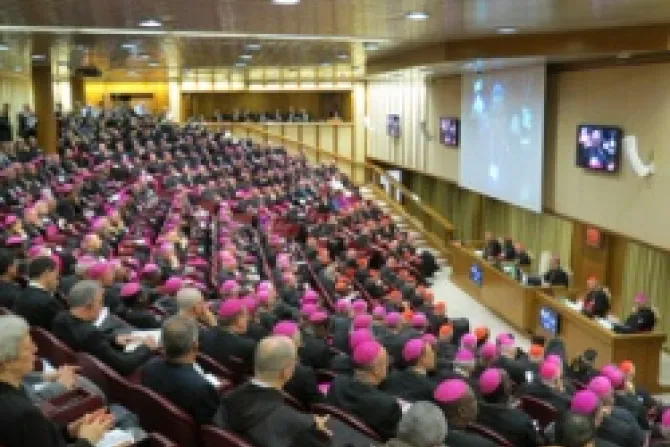Vatican City, Oct 10, 2013 / 23:10 pm
The vision of reforming the synod of bishops, an effort undertaken by Pope Francis, goes back to at least Pope Paul VI, who had even broader ideas for the synod, according to a leading Vatican analyst.
The synod of bishops, which acts as an advisory body to the Pope, was established by Paul VI in 1965 by the motu proprio Apostolica sollicitudo to "strengthen (the Pope's) union" with other bishops and to "establish even closer ties" with them.
The synod consists of a group of bishops from around the world who meet at fixed times "to foster closer unity between the Roman Pontiff and bishops, to assist the Roman Pontiff with their counsel … and to consider questions pertaining to the activity of the Church in the world," according to canon law.
Members of the synod are for the most part elected by their brother bishops for a three-year term.
Benny Lai, who has covered the Vatican since 1951 and is styled in Italian "the dean of Vaticanisti," told CNA Oct. 7 that "Paul VI even considered enrolling in the (papal) conclave…the 15 bishops of the 'board' of the synod of bishops."
According to Lai, who was a friend and biographer of the late Cardinal Giuseppe Siri, Archbishop of Genoa, the cardinal "convinced Paul VI not to do this (only) after an hour-and-a-half conversation."
Cardinal Siri argued that "enrolling in the conclave both the cardinals, chosen by the Pope, and the bishops, elected by the episcopal conferences, could lead to a 'split', since cardinals do not have to meet anyone's expectations, while the members of the synod must account for their decisions to their electors, and so could be influenced."
It was this fear of a possible "external" influence on the conclave that led Paul VI to state definitively that "only the Sacred College (of cardinals) will elect the Pope."
While Pope Francis plans a reform of the synod of bishops, it is not expected he will go so far as to include them among the Papal electors.
However, the prominence of synods could become a key theme of this pontificate. His reformation may lead to a permanent assembly of the synod of bishops, to be held in Rome, which dialogues with local Churches.
The synod of bishops first took shape during the Second Vatican Council, under the auspices of Pope Paul VI. Worried by the possibility of a lack of coordination between the Roman Church and other local Churches, he attached a preliminary note to the conciliar document on the Church, Lumen gentium.
In a July 1 blog post at America Magazine, Fr. Drew Christiansen observed that this preliminary note taught that synods would not "prejudice the rights and privileges of the Pope and the Holy See, which is why the synod has been a consultative but not deliberative body."
Synods currently depend on Papal endorsement, Fr. Christiansen said; their conclusions typically take the form of an apostolic exhortation issued by the Pope himself.
But from the beginning of his pontificate, Pope Francis has shown a wish for greater representation in the governance of the Church, and has indeed appointed a council of eight cardinals to advise him on curial reform.
Fr. Christiansen said he has also "indicated (this) council may be replaced in the years ahead by a council elected by the Synod."
The synod's last meeting was held in 2012 and concerned the new evangelization. Its next meeting, to discuss the family, was announced recently, and will take place in the autumn of 2014.
(Story continues below)
"This is the way in which the Pope intends to promote reflection and to guide the path of the community of the Church, with the responsible participation of the episcopate from different parts of the world," Vatican spokesman Fr. Federico Lombardi said Oct. 8.
Fr. Lombardi also stressed the importance of the Church moving "as a community in reflection and prayer."



